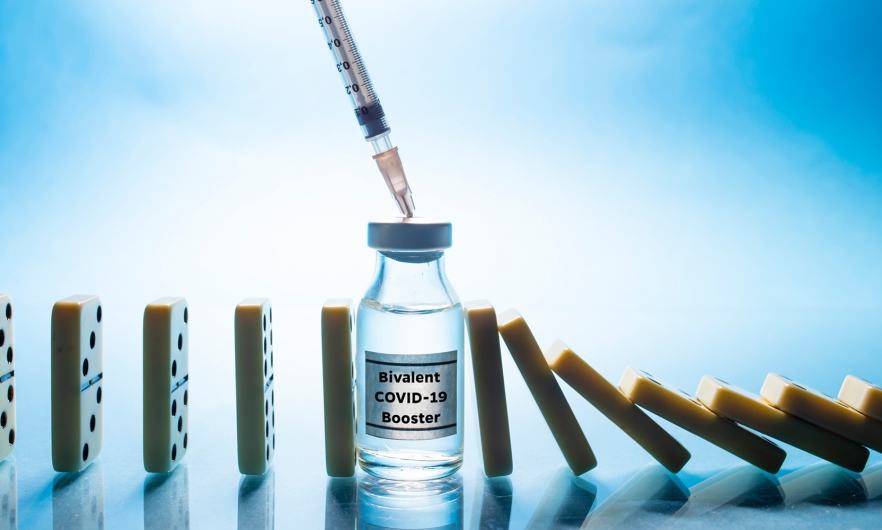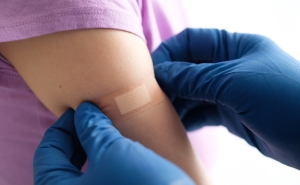Bivalent Covid-19 Booster Updates
Bivalent COVID-19 boosters offer the best protection against current strains.

This article was updated on January 23, 2023, to reflect the most recent information and recommendations.
The original COVID-19 boosters did a great job of preventing severe illness and hospitalization, even during the delta surge. Then came omicron and its subvariants, which not only were more transmissible than previous variants but evaded infection- and vaccine-provoked immunity. The boosters needed an update.
In this Q&A, adapted from the October 3 episode of Public Health On Call, Stephanie Desmon speaks with virologist Andy Pekosz, PhD, a professor in Molecular Microbiology and Immunology, about what makes bivalent boosters different—and more effective. Pekosz discusses who should get the bivalent shot and when, whether it’s safe to get it at the same time as the flu shot, and more.
What is the bivalent booster?
The bivalent booster is the most recent version of the COVID-19 vaccine. It contains both the original vaccine strain [of the virus] and a strain derived from the BA.5 omicron variant, which is currently dominating here in the U.S., so that we can maximize protection against severe disease and potentially from infection.
Who should be getting one? And when?
Bivalent boosters are available for people ages 6 months and older who have completed their COVID-19 vaccine primary series. The CDC recommends one bivalent booster dose:
- For everyone ages 5 years and older if it has been at least two months since your last dose.
- For children ages 6 months–4 years who completed the Moderna primary series if it has been at least two months since their last dose.
The CDC offers guidance for all age groups and situations on its website, including an interactive questionnaire to help people determine if and when they or their children should get a booster.
I had COVID almost two months ago. When would I need my booster shot?
According to the latest CDC guidance, people who have not yet received a bivalent booster should get it at least three months after a COVID-19 infection. If that recommendation changes, it will be reflected on the CDC’s website.
So this booster may be the one that will protect us for the longest time.
This issue will always be the emergence of a variant with different properties—something we never can never predict.
While the BQ and XBB variant families, which took hold in the U.S. in late 2022, are more immune-evasive than the original omicron strain, the bivalent booster still appears to be effective in reducing the risk of severe disease. If you’re eligible to receive the bivalent booster, get it.
Should people who’ve had two initial doses and two booster shots be getting this booster now?
Yes, because the bivalent booster will give you a better response to the currently circulating variants. The CDC recommendation is that everyone 5 years and older get the bivalent booster at least two months after their last dose or at least three months after a COVID-19 infection. There is also some data that suggest waiting as long as six months after your last dose may help establish a stronger, longer-lived immune response.
We’ve shifted from the pandemic strategy—getting immunity as fast as possible to as many people as possible—to the strategy of getting long-term immunity to people. Hopefully we can avoid having boosters every few months to try to maintain protection in the population.
Should kids and teens who had the original vaccines and a booster get the bivalent booster?
Yes. And again, four to six months after that last booster is a good time to get the bivalent booster. That will increase your [immune system’s] long-term memory, as well as give you better protection against the circulating viruses.
At the beginning of the pandemic, it was really straightforward: You were either infected or you weren’t. And then we got the vaccine. Now we have combinations of vaccination and infection. Maybe some people got infected and then vaccinated; maybe some people got infected before the booster and then got a booster afterward. All of these different combinations are going to give a slightly different immune response. It’s getting more and more difficult to make simple, straightforward statements about what’s best for people because there’s so much difference in their immune responses based on their exposure history.
Are we seeing any changes in the side effects from the bivalent booster?
No, everything’s the same as has been reported with the original bivalent booster. It’s important to note that the dose of this bivalent booster is exactly the same as the dose of the previous booster. It’s just that there are two different forms of the spike protein in the vaccine. All the reported side effects are essentially the same as with the boosters.
What do we know about how well the bivalent vaccine actually works?
The FDA saw data from both Moderna and Pfizer in June that showed that a bivalent vaccine induced better responses against omicron than another dose of the original booster vaccine. Up until then, they had tried bivalent vaccines with other variants, but they never performed better than the booster with just the original vaccine strain.
Then, in June, the [omicron] bivalent booster data showed that it was better [than the original booster]. But the FDA went one step ahead and said, “the data we saw was with another omicron variant, BA.1. But we know that BA.5 is now dominating,” So, they told the vaccine manufacturers to update that BA.1 to BA.5. In hindsight, that looks like a great move because we are maximizing the match between the circulating viruses and the vaccine strains.
What that means, though, is that we don’t have long-term studies in terms of how efficacious it is with this specific BA.5. We can infer from all the other studies that it will be good. But that’s the data we’re trying to collect through a number of studies going on right now.
Is vaccine-induced immunity better than immunity from infection?
Vaccine-induced immunity is better because it’s safer, and it induces the kind of immunity that is going to protect you from disease. When you get infected, you have all these other symptoms from the virus wreaking havoc in your system. The bivalent booster, particularly on top of an infection, is going to strengthen your immune responses to very high levels and do so in a safe way.
It will be important for individuals who’ve been infected to get the bivalent booster. The spacing will be the thing to think about—again, that four- to six-month window is what you need to strengthen [immune] responses and help them turn into long-term immunity.
WILL THERE BE AN UPDATED BIVALENT BOOSTER?
The SARS-CoV-2 virus has changed significantly since the bivalent boosters were initially rolled out. As such, we can expect an updated booster at some point in the future, but we don’t have any information on when that would be or what it would entail. For now, everyone should continue to follow the CDC guidance for staying up to date on vaccines. The FDA will be meeting to discuss a strategy for selecting future COVID-19 vaccines and the timing of the vaccinations, so we should have additional information soon.
Can you get the flu shot and the new booster at the same time?
Absolutely. CDC says there’s nothing wrong with getting both at the same time. I think it’s probably one of those situations where if you’re going in to get one, it’s probably good to get the other. We know from past experience that when people go in to get one vaccine and say, “Well, I’ll get the next one in a week or two,” a lot of them never come back. If you have the opportunity to get both, I would say get them at the same time. Both will be aiming to do the same thing: protect from severe disease. Many of the same populations that are vulnerable to severe COVID are the same populations that are vulnerable to severe influenza.
Is there any advantage to spreading them out?
Not really. The people who have been studied who have gotten both together don’t report any different side effects, any different adverse effects. If you do feel the need to split up your vaccines, get your COVID booster first because there’s a lot more COVID around right now than flu, and then go back and get your flu shot. But there really isn’t any reason why you shouldn’t get both at the same time.
Stephanie Desmon is the co-host of the Public Health On Call podcast. She is the director of public relations and marketing for the Johns Hopkins Center for Communication Programs, the largest center at the Johns Hopkins Bloomberg School of Public Health.





